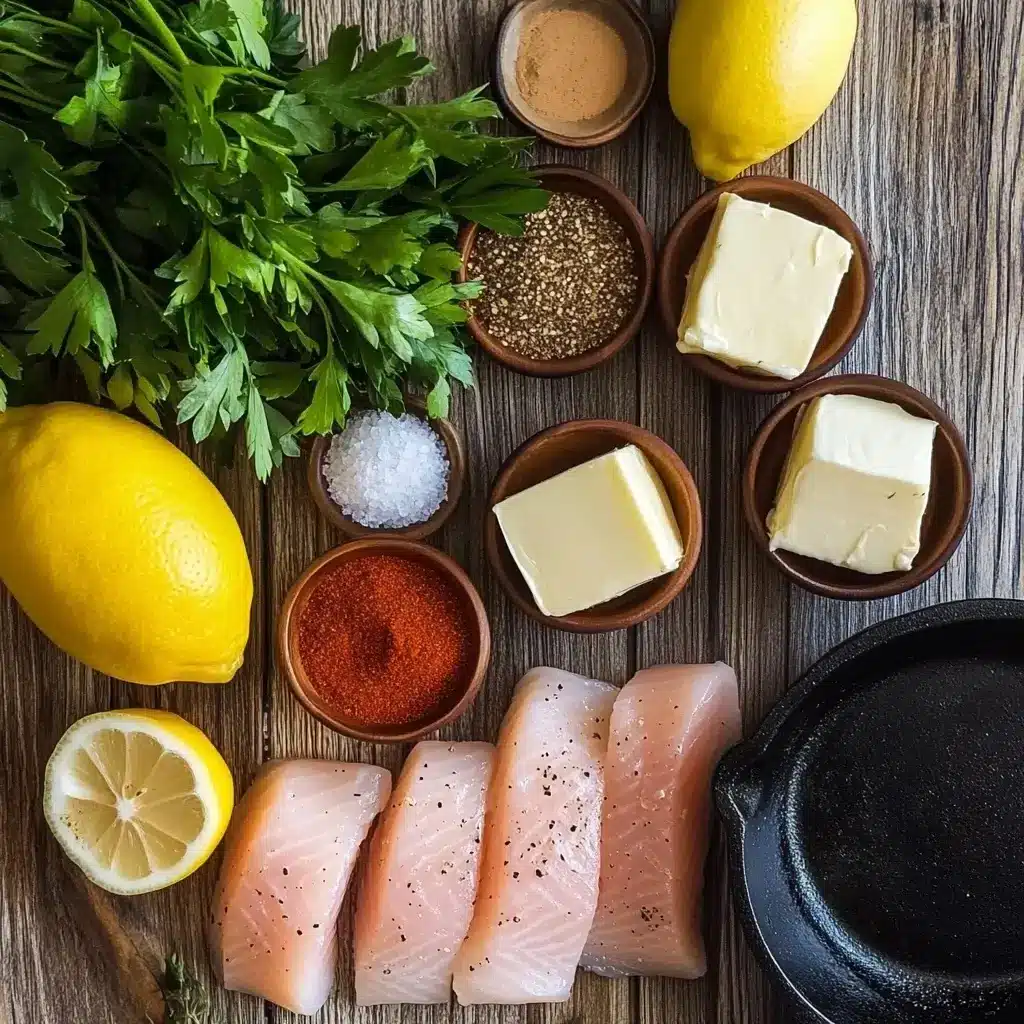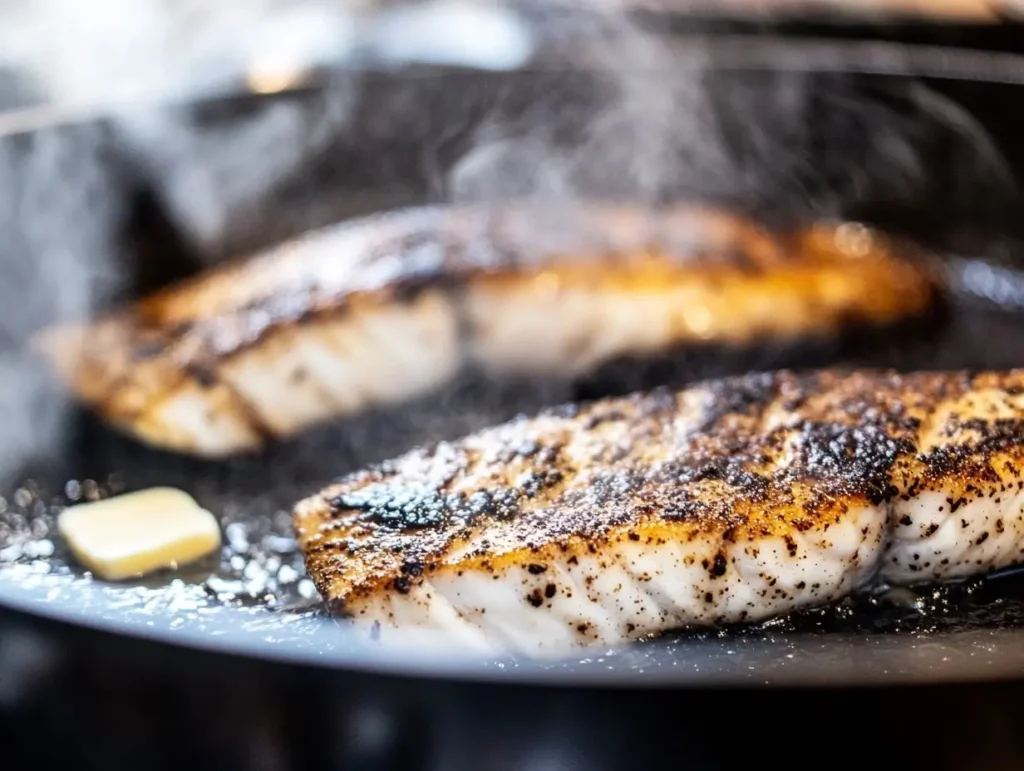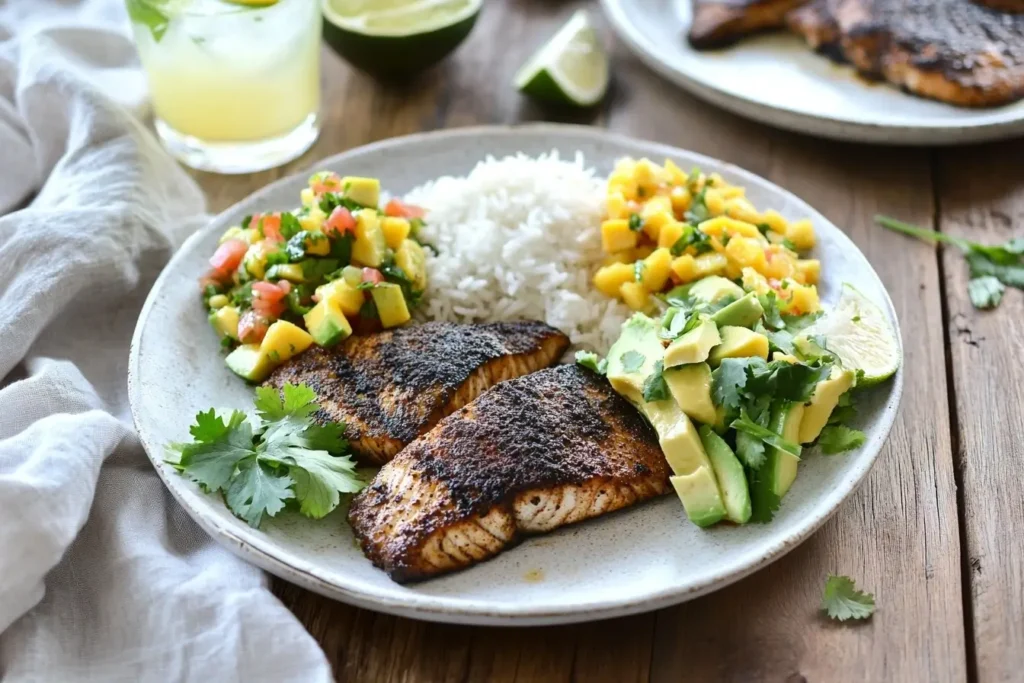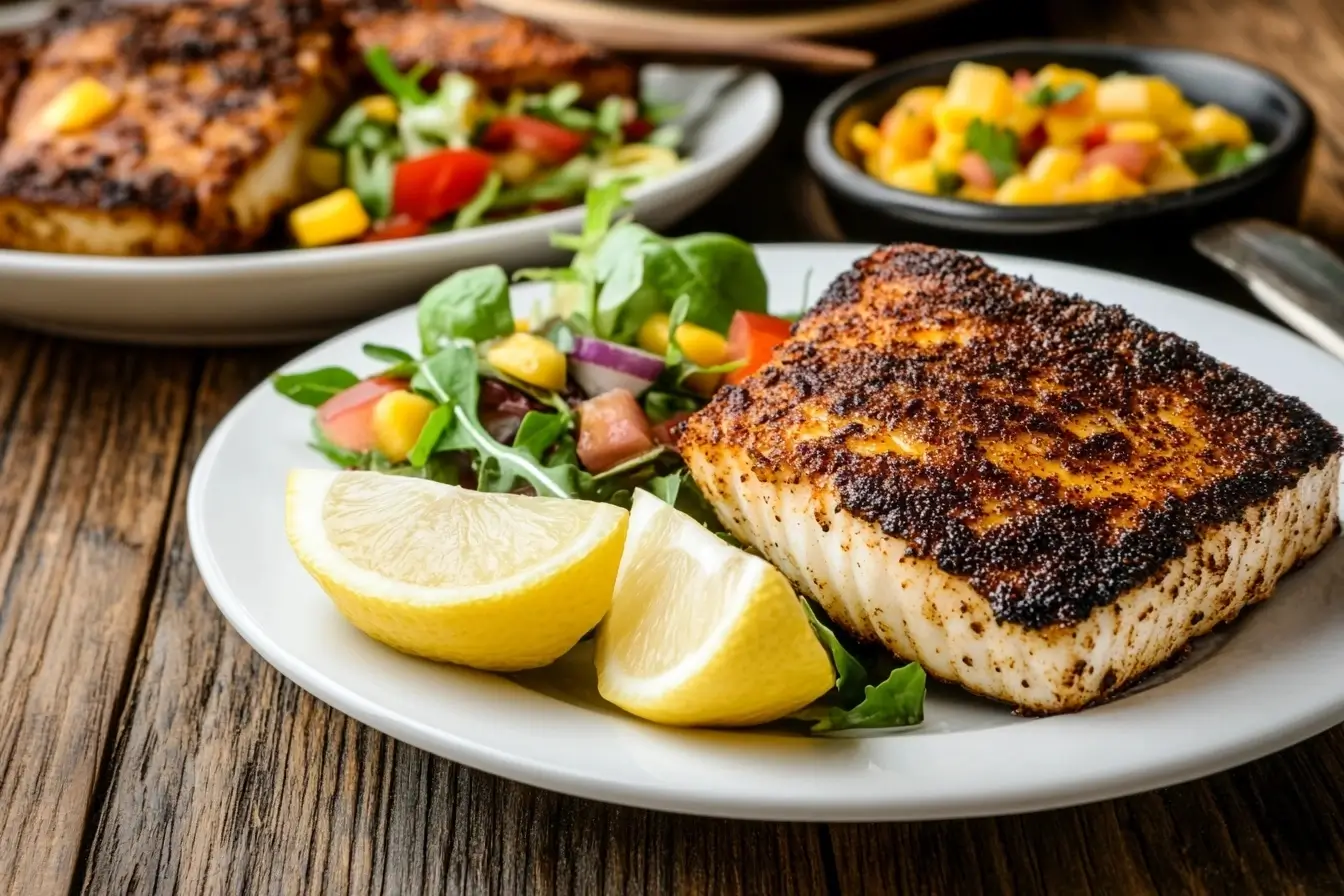Introduction
What is the difference between grilled and blackened mahi mahi? Many seafood lovers wonder which cooking method brings out the best flavors in this delicious fish. Both techniques have their unique appeal—grilling highlights the natural taste of mahi mahi, while blackening creates a spicy, crispy crust that locks in bold seasonings.
Growing up, I often watched my grandmother prepare grilled and blackened mahi mahi in our family kitchen. She believed that grilling was best for light and fresh meals, while blackening was perfect for those who enjoyed Cajun-inspired flavors. Whether you’re looking for a healthy grilled option or a bold blackened dish, knowing the difference between grilled and blackened mahi mahi will help you choose the best method for your next seafood meal.
In this guide, we’ll explore:
- How grilled and blackened mahi mahi differ in taste and texture.
- The best cooking techniques for each method.
- Health benefits and nutritional comparisons.
- Common FAQs about preparing mahi mahi.
By the end of this article, you’ll have a clear understanding of the difference between grilled and blackened mahi mahi and which one suits your taste and dietary preferences.
For a quick, flavorful, and easy blackened mahi mahi recipe, check out this Blackened Mahi Mahi Recipe – Quick, Flavorful, and Easy! to make it at home in just minutes!
Ingredients & Substitutions
Essential Ingredients for Grilled Mahi Mahi
Grilled Mahi Mahi is all about keeping things simple while letting the natural flavors of the fish shine through. To prepare a perfect grilled fillet, you will need:
- Fresh mahi mahi fillets – Aim for thick, firm fillets for best results.
- Olive oil or avocado oil – Helps prevent sticking and adds a hint of richness.
- Salt and black pepper – Basic but essential seasoning.
- Lemon or lime juice – Adds brightness to the dish.
- Garlic powder – Enhances the savory taste.
- Fresh herbs (optional) – Parsley, cilantro, or dill work well.
Substitutions for Grilled Mahi Mahi
Cooking for a busy family means flexibility is key. Here are some time-saving or alternative ingredients:
- Fish alternatives: If mahi mahi is unavailable, tilapia, cod, or halibut work well.
- Seasoning swaps: Instead of garlic powder, try onion powder or smoked paprika.
- Oil alternatives: Coconut oil or butter can be used instead of olive oil for a different flavor profile.
- Citrus variations: Lime juice gives a tropical taste, while orange juice adds a slight sweetness.
Essential Ingredients for Blackened Mahi Mahi
Blackening is all about bold, smoky flavors. Here’s what you’ll need:
- Mahi mahi fillets – Fresh or frozen fillets work as long as they are properly thawed.
- Butter or oil – Butter gives a richer taste, while oil is a lighter option.
- Blackening seasoning – A mix of spices that create a flavorful crust. Typically includes:
- Paprika
- Cayenne pepper
- Garlic powder
- Onion powder
- Dried oregano
- Dried thyme
- Black pepper
- Salt
- Lemon wedges – Helps balance the spice and adds freshness.
Substitutions for Blackened Mahi Mahi
- Butter alternatives: Olive oil or ghee work well.
- Less spice? Reduce the cayenne pepper for a milder version.
- More heat? Add extra chili powder or crushed red pepper flakes.
- Pre-made blackening seasoning: If short on time, store-bought blends can be used.
Why These Ingredients Matter
Grilled mahi mahi relies on simplicity to let the fish’s natural flavors shine, while blackened mahi mahi uses a spice-heavy approach to create a crispy, flavorful crust.

Grilling Technique
Why Grilling Works Well for Mahi Mahi
Grilling is one of the best ways to prepare mahi mahi because it enhances the fish’s natural flavors while keeping it light and tender. The high heat helps create a slightly charred exterior while locking in moisture, giving you a juicy, flaky texture.
One of my favorite memories is grilling mahi mahi with my grandmother on summer evenings. She always said, “A good grill brings out the best in fresh fish, and a squeeze of lemon seals the deal.” She was right—the simplicity of grilling makes it a go-to method for a quick, healthy, and flavorful meal.
How to Grill Mahi Mahi Like a Pro
Grilling mahi mahi is straightforward, but a few tricks can take it from good to great. Follow these steps for the best results:
1. Preparing the Grill
- Preheat the grill to medium-high heat (about 400°F).
- Clean and oil the grates to prevent sticking. A little olive oil on a paper towel works well.
- If using a charcoal grill, let the coals turn gray before cooking to get even heat.
2. Preparing the Mahi Mahi Fillets
- Pat the fish dry with a paper towel to remove excess moisture.
- Brush lightly with oil on both sides to prevent sticking.
- Season generously with salt, black pepper, garlic powder, and lemon juice.
- If marinating, let the fillets sit for 15-20 minutes before grilling for added flavor.
3. Grilling Process
- Place the mahi mahi fillets directly on the grill grates.
- Cook for 3-4 minutes per side, depending on thickness.
- Avoid flipping too early—wait until grill marks appear and the fish releases easily.
- The fish is done when it flakes easily with a fork and reaches an internal temperature of 137-140°F.
4. Optional: Using Foil for Delicate Fillets
If your fillets are thin or delicate, grilling directly on the grates may cause them to fall apart. Instead:
- Place the fillets on a foil sheet and fold the edges up.
- Add a little butter, lemon slices, and herbs.
- Grill for 5-6 minutes, steaming the fish while keeping it tender.
Common Mistakes to Avoid
Even experienced cooks can run into issues when grilling. Here’s what not to do: ✅ Don’t overcook – Mahi mahi cooks fast; leaving it on the grill too long dries it out.
✅ Don’t flip too soon – Let the grill marks form before flipping to avoid breaking the fillets.
✅ Don’t forget to oil the grill grates – Sticking fish is a common problem. Lightly oiling the grates helps.
✅ Don’t use high heat – Too much heat burns the outside before the inside is cooked.
Flavor & Texture of Grilled Mahi Mahi
Grilled mahi mahi has a light, slightly smoky taste with a firm, flaky texture. Unlike blackened mahi mahi, which has a strong, bold seasoning, grilled mahi mahi lets the fish’s natural sweetness stand out. This makes it a great option for those who enjoy milder, fresh flavors.
Best Side Dishes for Grilled Mahi Mahi
Pairing your grilled mahi mahi with the right sides can enhance its flavor. Here are some great options:
- Grilled vegetables (zucchini, bell peppers, or asparagus)
- Rice pilaf or quinoa for a hearty, balanced meal
- Mango salsa for a touch of sweetness
- Lemon-garlic butter sauce for added richness

Blackening Technique
What Makes Blackened Mahi Mahi Unique?
Blackening is a cooking method that gives mahi mahi a bold, spicy crust while keeping the inside tender and juicy. Unlike grilling, which enhances the fish’s natural sweetness, blackening relies on a blend of paprika, cayenne, garlic, and herbs to create a rich, flavorful crust.
My grandmother used to say, “Blackened fish isn’t just about the seasoning—it’s about the heat and the skillet you cook it in.” She was right. The secret to blackened mahi mahi lies in the intense heat that seals in flavor while forming a perfect crust.
How to Blacken Mahi Mahi Perfectly
Achieving the perfect blackened crust requires the right seasoning, a hot pan, and a bit of patience. Follow these steps for restaurant-quality blackened mahi mahi at home.
1. Choosing the Right Pan
- A cast-iron skillet is the best option because it retains heat well.
- If using a stainless steel pan, make sure it’s properly preheated before adding the fish.
- Non-stick pans are not ideal for blackening since they don’t hold enough heat.
2. Preparing the Mahi Mahi Fillets
- Pat the fillets dry with a paper towel to remove excess moisture. This helps the seasoning stick.
- Brush both sides lightly with melted butter or oil.
- Generously coat the fillets in a homemade blackening seasoning mix:
- 2 teaspoons paprika
- 1 teaspoon cayenne pepper (adjust for spice preference)
- 1 teaspoon garlic powder
- 1 teaspoon onion powder
- ½ teaspoon dried oregano
- ½ teaspoon dried thyme
- ½ teaspoon salt
- ½ teaspoon black pepper
- Press the seasoning into the fillets for a firm coating.
3. Heating the Pan & Cooking the Fish
- Preheat your cast-iron skillet over medium-high heat for at least 5 minutes.
- Add 1-2 tablespoons of butter or oil, allowing it to heat up until shimmering.
- Carefully place the mahi mahi fillets in the pan.
- Cook for 3-4 minutes per side until a dark crust forms.
- The fish is done when the internal temperature reaches 137-140°F and flakes easily with a fork.
4. Controlling the Smoke
Blackening produces a lot of smoke due to the high heat. Here’s how to manage it: ✅ Turn on the exhaust fan or open windows.
✅ Use a well-ventilated area or cook outdoors if possible.
✅ Avoid overcrowding the pan, which lowers the temperature and reduces smoke.
What Does Blackened Mahi Mahi Taste Like?
- Bold & Spicy: The cayenne pepper and paprika create a smoky, slightly spicy crust.
- Crispy Exterior: The blackening process locks in moisture while forming a flavorful crust.
- Juicy & Tender Inside: Unlike deep-frying, blackening keeps the inside of the fish moist and flaky.
Compared to grilled mahi mahi, which has a mild, smoky taste, blackened mahi mahi delivers a spicy, Cajun-inspired flavor.
Best Side Dishes for Blackened Mahi Mahi
Pair your blackened mahi mahi with fresh, cooling sides to balance the heat:
- Coleslaw – Creamy and refreshing, perfect for cutting through spice.
- Coconut rice – Adds a touch of sweetness.
- Avocado salad – Light and creamy to complement the bold seasoning.
- Corn on the cob – Slightly sweet and a great texture contrast.
Comparing Grilled and Blackened Mahi Mahi
Key Differences Between Grilled and Blackened Mahi Mahi
Both grilled and blackened mahi mahi are delicious, but they bring out different flavors, textures, and nutritional benefits. Here’s how they compare:
| Feature | Grilled Mahi Mahi | Blackened Mahi Mahi |
|---|---|---|
| Cooking Method | Cooked over an open flame or grill grates. | Seared in a hot cast-iron skillet with butter and spices. |
| Flavor Profile | Mild, slightly smoky, and fresh. | Bold, spicy, with a crispy, flavorful crust. |
| Texture | Firm yet flaky, lightly charred. | Crispy outside, tender inside. |
| Heat Level | Mild; relies on natural fish flavor. | Spicy; seasoning creates a bold kick. |
| Cooking Time | About 6-8 minutes total. | About 6-8 minutes total. |
| Nutritional Differences | Lower in fat; light oil use. | Higher fat content (due to butter). |
| Best For | Light, healthy meals, seafood lovers who enjoy mild flavors. | Those who love bold, Cajun-style dishes with spice. |
Grilled mahi mahi is light and simple, making it a great choice for those who want to enjoy the natural flavor of the fish. On the other hand, blackened mahi mahi is bold and spicy, thanks to the heavy seasoning and searing technique.
Cooking Techniques: A Side-by-Side Comparison
Cooking grilled mahi mahi is all about slow, even heat, while blackening relies on intense, quick searing.
Grilling Process
- Uses direct heat to cook the fish gradually.
- Oil and seasoning are minimal.
- Requires flipping only once to prevent sticking.
- Ideal for outdoor cooking.
Blackening Process
- Uses high heat in a skillet.
- Heavy butter and spice coating create the crust.
- Cooks quickly in a hot pan.
- Produces more smoke (best with good ventilation).
Health Considerations
Both grilled and blackened mahi mahi can be healthy, depending on how they are prepared. However, there are some differences in calorie count, fat content, and nutrient retention. According to Healthline, grilled fish is often lower in fat, while blackened fish may contain more sodium due to the seasoning mix. Choosing the right preparation method depends on your dietary goals.
Calories & Fat
- Grilled Mahi Mahi is generally lower in fat and calories because it uses less oil or butter.
- Blackened Mahi Mahi has a richer texture due to the butter-based seasoning, which adds extra calories.
Nutrient Retention
- Grilling helps retain omega-3 fatty acids, essential for heart health.
- Blackening locks in moisture but may have higher sodium content due to the spice blend.
Dietary Preferences
- Grilled mahi mahi is ideal for low-fat and heart-healthy diets.
- Blackened mahi mahi is best for those who love bold flavors and don’t mind a little extra butter.
Which One Should You Choose?
The answer depends on your taste preferences and health goals.
Choose Grilled Mahi Mahi if you: ✅ Prefer a light, fresh taste.
✅ Want a simple, low-calorie meal.
✅ Enjoy mild seasonings and natural fish flavors.
Choose Blackened Mahi Mahi if you: ✅ Love bold, spicy flavors.
✅ Enjoy crispy textures and rich seasonings.
✅ Don’t mind a little butter for extra flavor.

How to Make Blackened Mahi Mahi?
Making blackened mahi mahi is simple, but the key lies in the seasoning and high-heat cooking. Here’s a step-by-step guide:
Ingredients:
2 mahi mahi fillets
2 tablespoons butter (melted)
2 teaspoons paprika
1 teaspoon cayenne pepper (adjust for spice preference)
1 teaspoon garlic powder
1 teaspoon onion powder
½ teaspoon dried oregano
½ teaspoon dried thyme
½ teaspoon salt
½ teaspoon black pepper
1 tablespoon oil (for cooking)
Instructions:
Prepare the Fish – Pat the mahi mahi fillets dry with a paper towel. Brush them with melted butter.
Coat with Seasoning – Mix the blackening seasoning in a bowl. Press it onto both sides of the fillets.
Heat the Pan – Preheat a cast-iron skillet over medium-high heat for at least 5 minutes.
Cook the Fish – Add 1 tablespoon oil to the pan. Carefully place the fillets in the pan.
Sear on Each Side – Cook for 3-4 minutes per side, or until a crispy blackened crust forms.
Check Doneness – The fish is done when it flakes easily and reaches an internal temperature of 137-140°F.
Serve Immediately – Enjoy with fresh lemon wedges and your favorite side dishes!
If you want to try a step-by-step blackened mahi mahi recipe, check out our Easy Blackened Mahi Mahi Recipe – How to Make It at Home for full instructions and pro tips!
What Spices Are Good with Mahi Mahi?
Mahi mahi is a versatile fish, and the seasoning depends on the cooking method. Here are some great spice options:
For a Mild, Fresh Flavor (Grilled Mahi Mahi)
Garlic powder
Lemon pepper
Dill
Parsley
Salt & black pepper
For a Bold, Spicy Flavor (Blackened Mahi Mahi)
Paprika
Cayenne pepper
Onion powder
Oregano
Thyme
Smoked salt
For a Citrus-Infused Flavor
Lime zest
Cumin
Coriander
Chili powder
Whether you prefer a simple, herby blend or a spicy, Cajun-style seasoning, mahi mahi can handle a wide range of flavors.
Check out our in-depth seasoning guide: What Spices Are Good with Mahi Mahi? Best Seasoning Guide for a complete list of the best spices and herbs to enhance your dish.
What Fish Can I Use Instead of Mahi Mahi for This Recipe?
If mahi mahi isn’t available, here are some great substitutes based on texture and flavor:
Best Substitutes for Grilled or Blackened Mahi Mahi
Halibut – A firm, meaty fish that holds up well to grilling and blackening.
Tilapia – A mild, affordable alternative, though slightly less firm.
Grouper – Similar in texture, slightly sweeter in flavor.
Snapper – Has a mild, slightly sweet taste, perfect for grilling or blackening.
Cod – A flakier option that works well for blackened seasoning but is more delicate on the grill.
If you’re using tilapia or cod, be careful when grilling, as they are softer and may break apart.
What to Serve with Blackened Mahi Mahi?
Since blackened mahi mahi has bold and spicy flavors, pairing it with refreshing and mild sides balances the dish. Here are some great options:
Fresh & Cooling Sides
Mango salsa – A touch of sweetness complements the spice.
Avocado salad – Creamy avocado balances the bold flavors.
Coleslaw – A crunchy, tangy side to contrast the spice.
Carb-Based Sides
Coconut rice – Lightly sweet and pairs well with the blackening spices.
Quinoa salad – A healthy, protein-packed option.
Cornbread – Adds a slight sweetness to balance the seasoning.
Vegetable-Based Sides
Grilled asparagus – Lightly charred for a smoky taste.
Roasted sweet potatoes – A slightly sweet side that balances the heat.
Steamed broccoli – A simple and nutritious pairing.
Looking for more side dish ideas to pair with your blackened mahi mahi? Check out our complete guide: What to Serve with Blackened Mahi Mahi: Best Side Dishes & Pairings. This article features the best rice dishes, grilled vegetables, and sauces to balance the bold flavors of blackened seasoning.
Final Thoughts
Grilled vs. Blackened Mahi Mahi – Which One Is Right for You?
At the end of the day, both grilled and blackened mahi mahi offer something special. If you love light, fresh flavors with a subtle smokiness, then grilled mahi mahi is your best bet. On the other hand, if you prefer bold, spicy, and crispy textures, blackened mahi mahi is the way to go.
Each cooking method brings out different qualities in the fish: ✅ Grilled Mahi Mahi – Clean, mild, and slightly smoky, perfect for a refreshing meal.
✅ Blackened Mahi Mahi – Spicy, crispy, and flavorful, great for those who enjoy bold seasonings.
Whether you’re cooking for yourself or a family dinner, knowing how to prepare mahi mahi in different ways allows you to switch things up based on your mood or dietary needs.
Personal Take: The Best Way to Cook Mahi Mahi
For me, the choice depends on the occasion. On busy weeknights, I prefer grilled mahi mahi because it’s quick, simple, and easy to clean up. But when I’m craving something flavorful, blackened mahi mahi is my go-to. The crispy spice crust pairs so well with creamy avocado salad or a side of coconut rice.
Either way, mahi mahi is a fantastic fish that adapts to different cooking styles. Whether you grill it or blacken it, you can’t go wrong!
Try It Yourself!
Now that you know the difference between grilled and blackened mahi mahi, why not try both methods and see which one you like best?
Let me know in the comments: Are you Team Grilled or Team Blackened? 😄
Happy cooking! 🎣🔥

